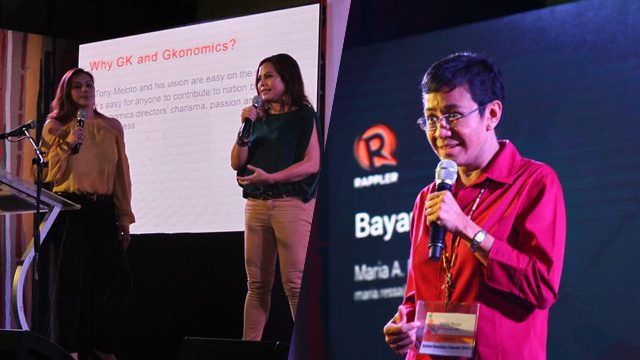SUMMARY
This is AI generated summarization, which may have errors. For context, always refer to the full article.

BULACAN, Philippines – “The notion of nation building is scary,” interior designer Cynthia Almario told participants at the Gawad Kalinga’s Social Business Summit 2014 on October 2.
How can tourism, design and online media help build a nation? Interior designers Cynthia and Ivy Almario; Rappler CEO Maria Ressa; and Department of Tourism Assistant Secretary Bong Bengzon shared their thoughts on how to do it during a panel discussion.
Social design
Cynthia and sister Ivy, also an interior designer, own Atelier Almario. Their portfolio includes many luxury hotels and homes around the Philippines and abroad including the Astoria in Boracay and Movenpick Hotel in Cebu.
Their edge? “Our design solutions are always innovative and fresh,” Cynthia said.
Without hesitation, the sisters said they agreed to design for GKonomics which, according to the GKonomics website, “facilitates the social entrepreneur’s partnership by forming strategic partnerships between the entrepreneur and GK’s communities.”
Ivy explained, “We’re very conscious in highlighting Filipino talent.”
Cynthia said, “Our model: Existing skills plus good design and production expertise equals value creation. Because of this model, fund generation is in waves instead of trickles.”
Ivy also echoed the summit’s underlying theme. “Collaboration is key, everything is Bayanihan,” she said.
Social tourism
According to Tourism Assistant Secretary Bong Bengzon, tourism will be a major driver of growth in the Philippines. “More inclusive growth, higher job creation, quality of life for our kababayans – the DOT has crafted a blueprint for the development of tourism in the Philippines,” he said.
Bengzon said the DOT’s growth targets have put pressure on agencies to upgrade the poor state of the country’s infrastructure. He also said that economic growth has given a boost to the tourism sector.
“Overall, the improving economy has provided tremendous boosts in tourism. Last month, the World Economic Forum bumped up the Philippines 7 notches in the competitiveness index. We believe that social tourism can be effective in promoting the country,” Bengzon said.
He added, “Over 1 billion people traveled in 2012, so someday all mid to upper level income people will travel.”
But there’s a difference between social tourism to normal tourism. Social tourists “will not travel to go to a place but to meet people.”
He noted the rise in social tourism after Typhoon Yolanda. “Tourism agencies and individuals raised their hands and asked, ‘How can I help?'”
This year, the DOT plans to rev up its already popular “More Fun in the Philippines” social media campaign with a more regional focus, as he showed the new advertisements promoting Cebu, Davao, Boracay, and Manila.
“I know that social tourism will flourish in the Philippines,” Bengzon concluded.
Online bayanihan
Rappler CEO and Executive Editor Maria Ressa joined the panel to discuss nation building through online media. “I’ve been sitting here less than an hour and I’ve heard these words repeatedly: Bayanihan (community) and inspiration.”
In the past, the news wasn’t always thought of as a part of the nation building process. Ressa said, “As I got older, I realized yes, great activism sits on great journalism.”
She related bayanihan to crowdsourcing. “Technology is magic. There are many things that technology enables,” Ressa explained.
One important aspect that technology enables online media to do is to collaborate with citizens. Citizen journalists are now telling their own stories.
“The reason we succeed is because you do it. Twenty percent of content is from you, the crowd,” Ressa said.
Beyond storytelling, Rappler’s Project Agos is an online platform that brings together non-governmental organizations, government agencies, citizens, and the media to move the community to prepare for disaster, to bring quicker responses to those who need help, and keep the public engaged in monitoring or participating in recovery efforts.
Ressa said, “The crowd is magical. They allow journalists to do more than just tell stories. If you are not using the people who believe in you, you are missing it.” – Rappler.com
See related stories:
- Social entrepreneurship: Ending poverty from the bottom up
- ‘Walang iwanan’ economy: Bridging markets, communities
- How to #EndPoverty? Develop state universities
- In entrepreneurship, ‘responsibility key to sustainability’
- The way to inclusive growth: ‘Create shared value’
- ‘We need prosperity to sustain peace’
Follow Rappler’s live blog of Gawad Kalinga’s Social Business Summit here.
Add a comment
How does this make you feel?
There are no comments yet. Add your comment to start the conversation.